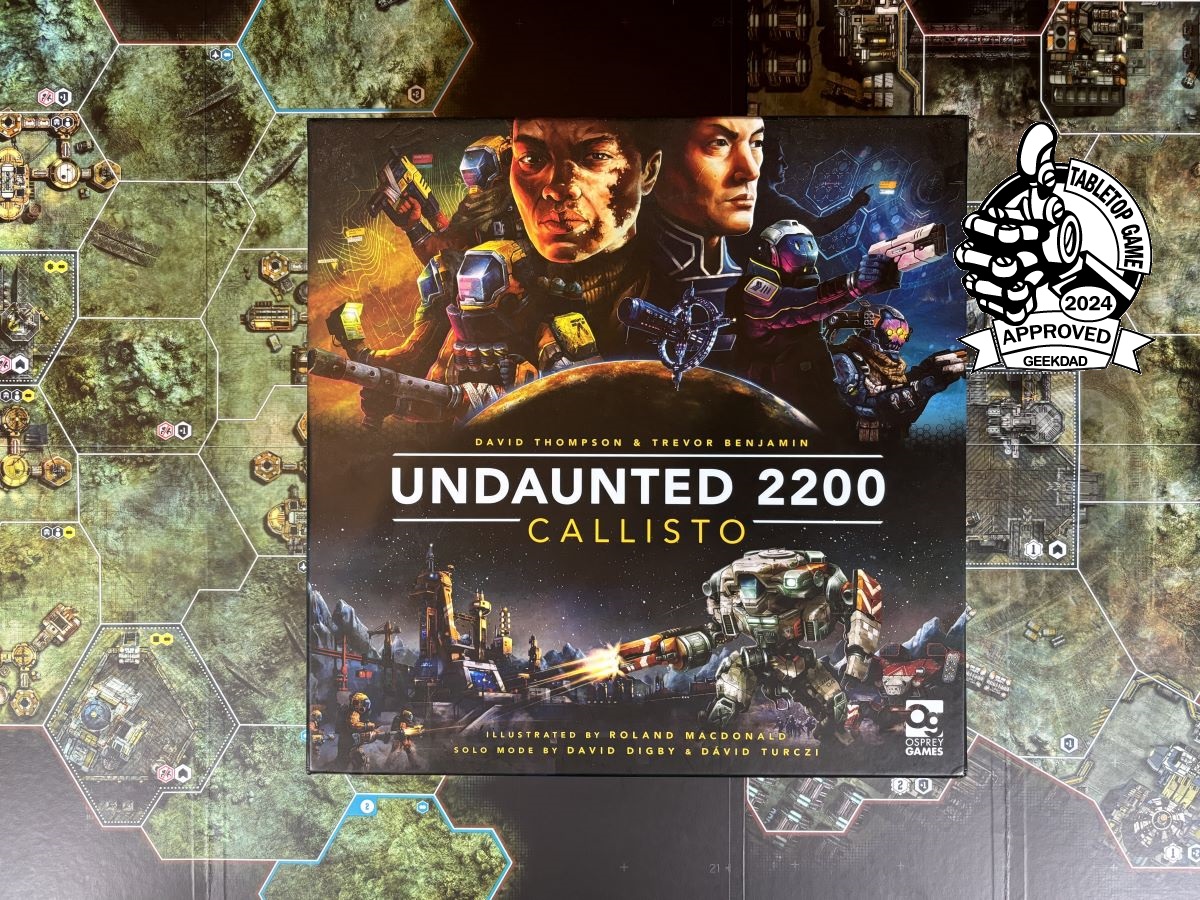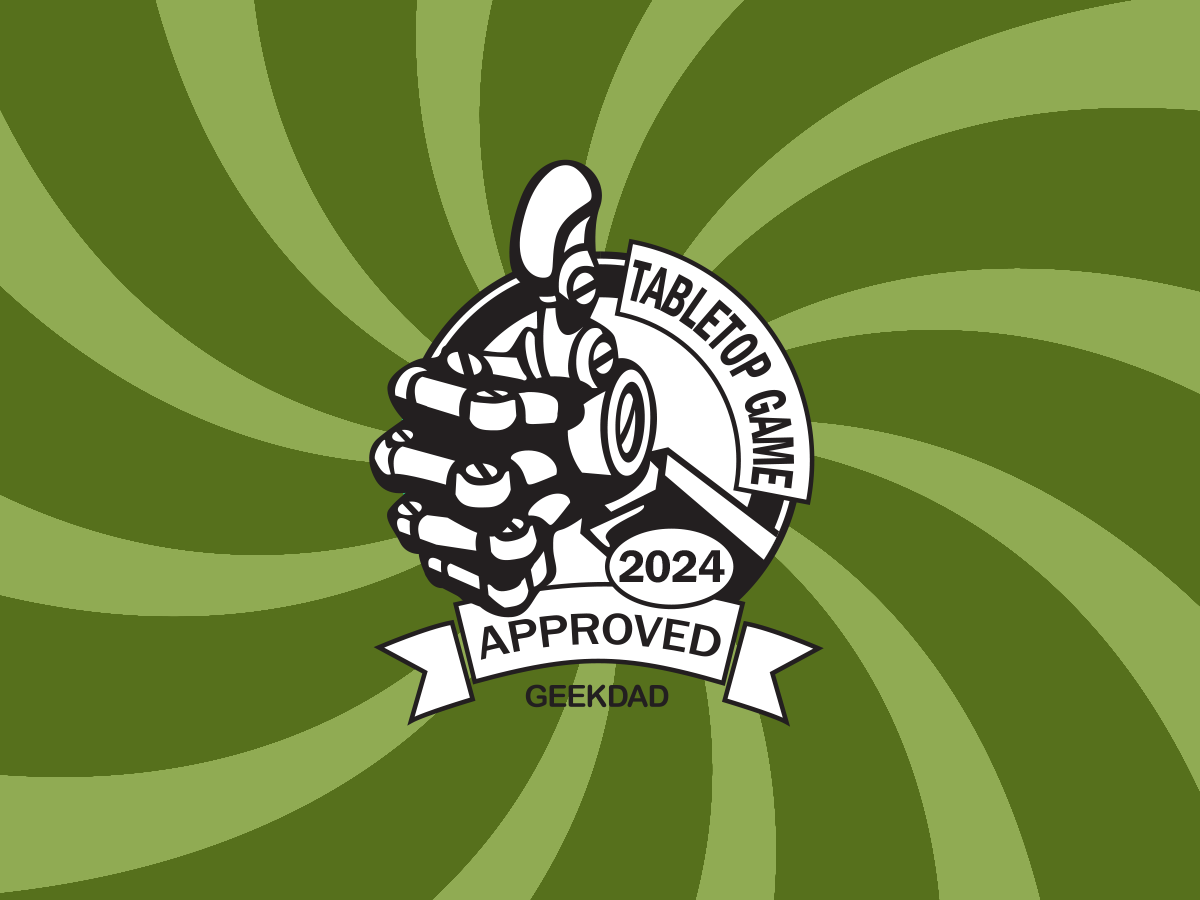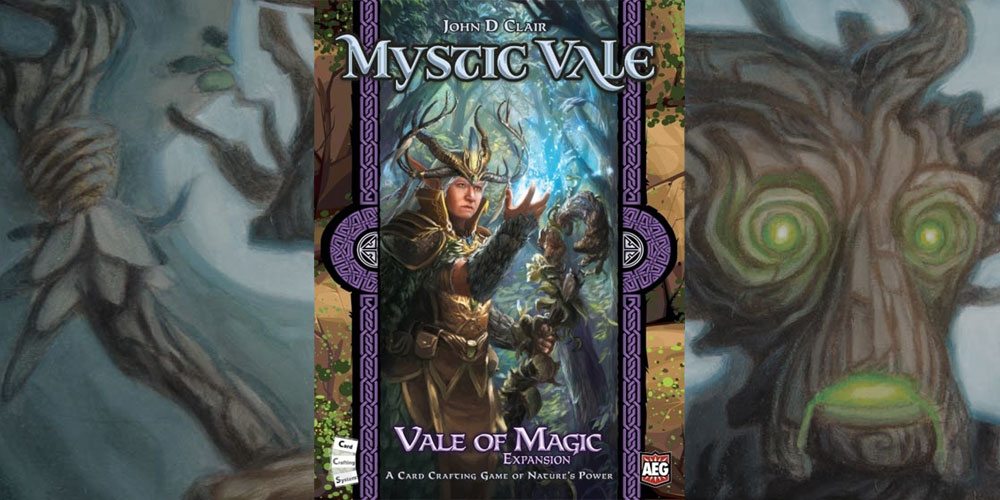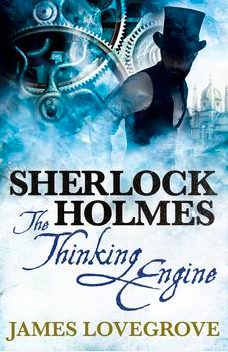I have been playing tabletop wargames for around 40 years. Some have used cardboard counters while others has plastic miniatures. A few used decks of cards to represent units, actions, and terrain. A few years ago I came across a game set during WWII that featured one of my favorites game mechanics, deck building. While some card wargames used abstract methods to create a battlefield, this game actually had maps with markers for the units on it. I was immediately fascinated by Undaunted: Normandy, which was released in 2019. Undaunted: North Africa, a stand-alone sequel, was released in 2020 and took the series not only to a new location but also added new ways to play including vehicles. Undaunted: Reinforcements (2021)was an expansion for both of the earlier titles and also included a great solo play system. This was followed by Undaunted: Stalingrad (2022) which took the series to the Eastern Front as well as introduced a campaign system similar to a legacy system. This was a massive game and quickly became a favorite. Next, the series left the ground and took to the skies with Undaunted: Battle of Britain (2023) which included new features to represent the non-stop action of aerial combat. Now Undaunted 2200: Callisto has arrived which takes the series off planet to a colony on one of the moons of Jupiter with a science fiction theme.
What Is Undaunted 2200: Callisto?
Undaunted 2200: Callisto is the latest game in the Undaunted series. Players take on the roles of either the Lunar Frontier Authority (LFA) and the workers of a local mining branch known at the ‘Breakers’. The game is for 1, 2 or 4 players, ages 14 and up, and takes about 45-60 minutes to play. Undaunted 2200: Callisto is currently available from your FLGS or online retailers such as Amazon for about $66 for a copy of the game. Undaunted 2200: Callisto was designed by David Thompson and Trevor Benjamin, published by Osprey Games, with illustrations by Roland MacDonald. The Solo Mode is by David Digby and David Turczi and the narrative for the game was written by Robbie MacNiven.
Undaunted 2200: Callisto Components
Here is what you get in the box:
- 4 Double-sided mapboards
- 68 Breaker cards
- 13 Breaker personnel counters
- 21 Breaker control markers
- 2 Breaker standees
- 67 LFA cards
- 8 LFA personnel counters
- 21 LFA control markers
- 5 LFA standees
- 7 Ready standee bases
- 7 Suppressed standee bases
- 30 Markers
- 12 Dice (4 x d8, 4 x d10, 4 x d12)
- 1 Rulebook
- 1 Scenario book
- 1 Solo book
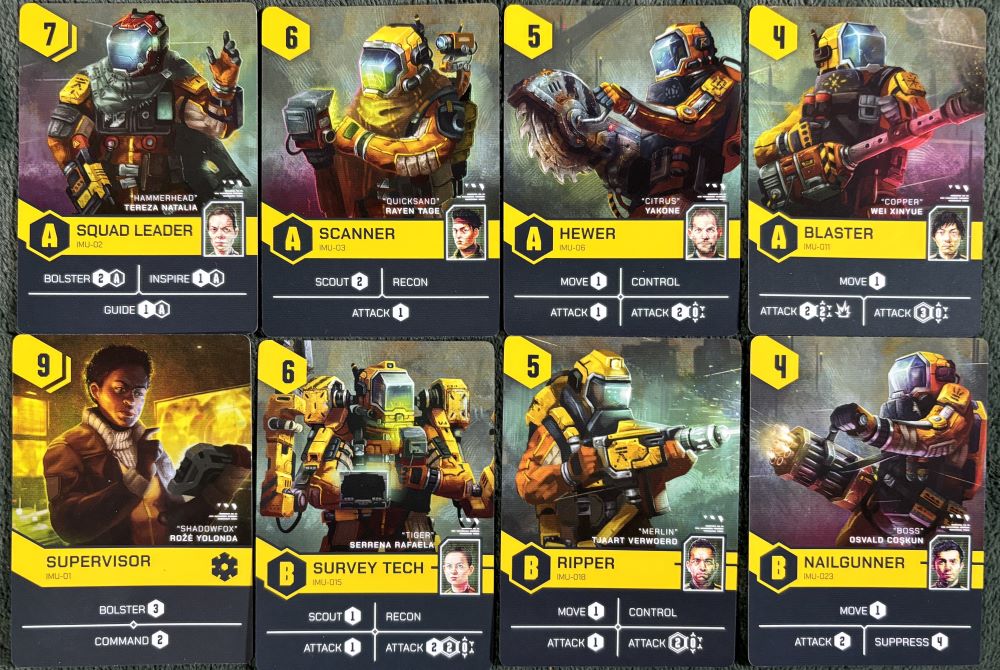
The Breakers are not regular soldiers. Instead, they are miners who are in rebellion. Many of their weapons are equipment they use for their jobs. Some are armed with saws while others use nailguns. These units consist of leaders who support the troops as well as squads of fighters who move across the battlefield and fight. The Breakers have four different squads.
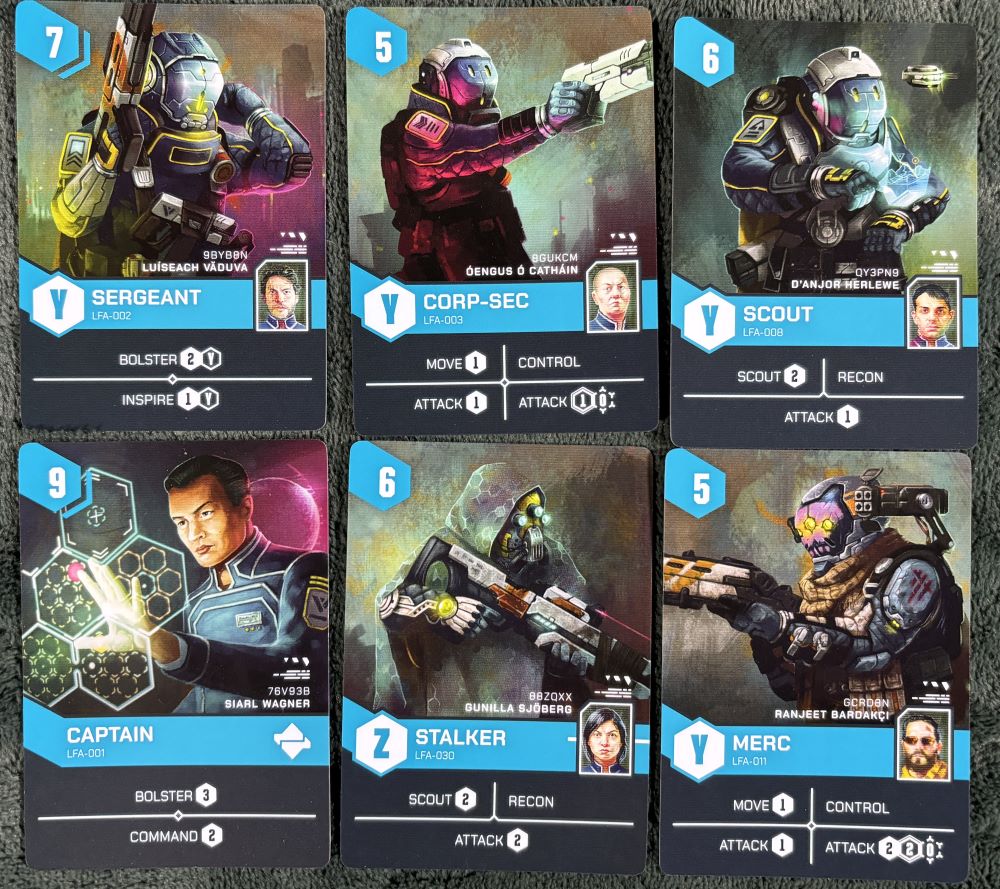
The LFA forces consist of trained soldiers and security forces with proper weapons. They also employ mercenaries which can be very effective at fighting. Like the Breakers, they also have leaders who support the soldiers. However, they only have two squads.
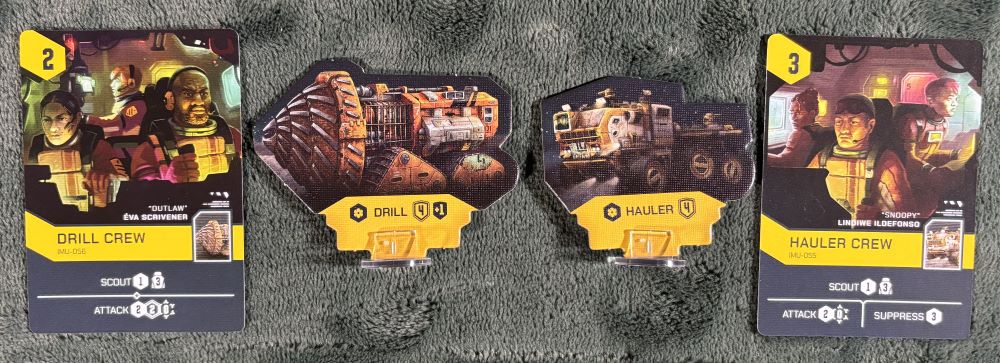
The Breaker vehicles are industrial machines. They are operated by crew cards that allow these units to complete several different functions. In addition, these vehicles can also carry up to three other friendly units with them when the move allowing the Breakers to quickly move several units into the fight. These vehicles are represented by standees on the mapboards.
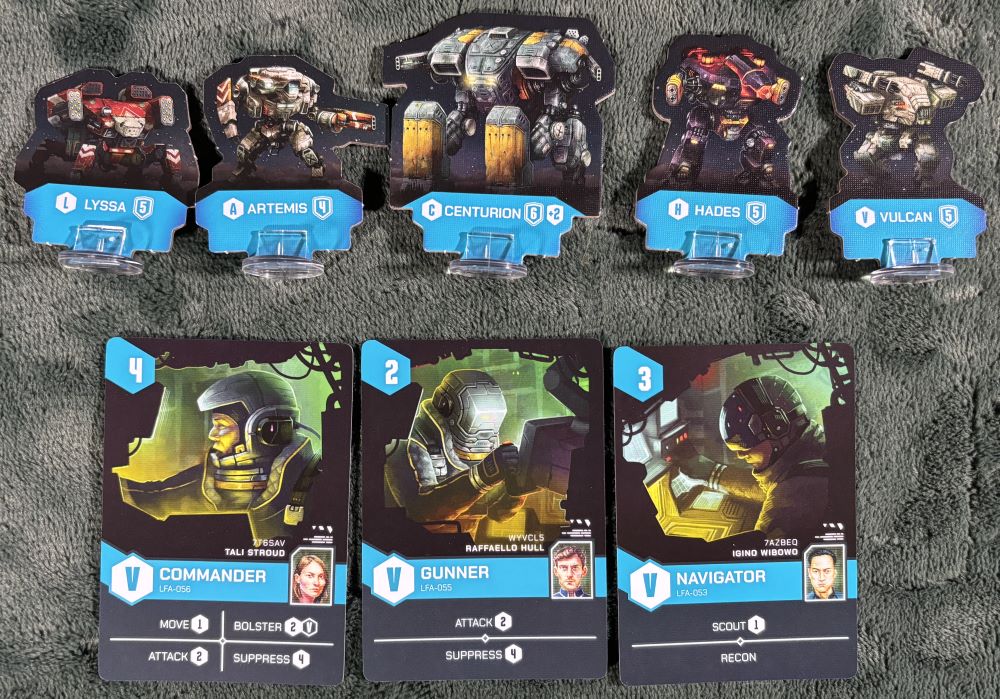
Unlike the Breaker vehicles, the LFA is equipped with battle mechs. Instead of a consolidated crew, each of the five different mechs has their own crew with three different positions which include commander, navigator, and gunner. Standees are used for these mechs on the battlefield.
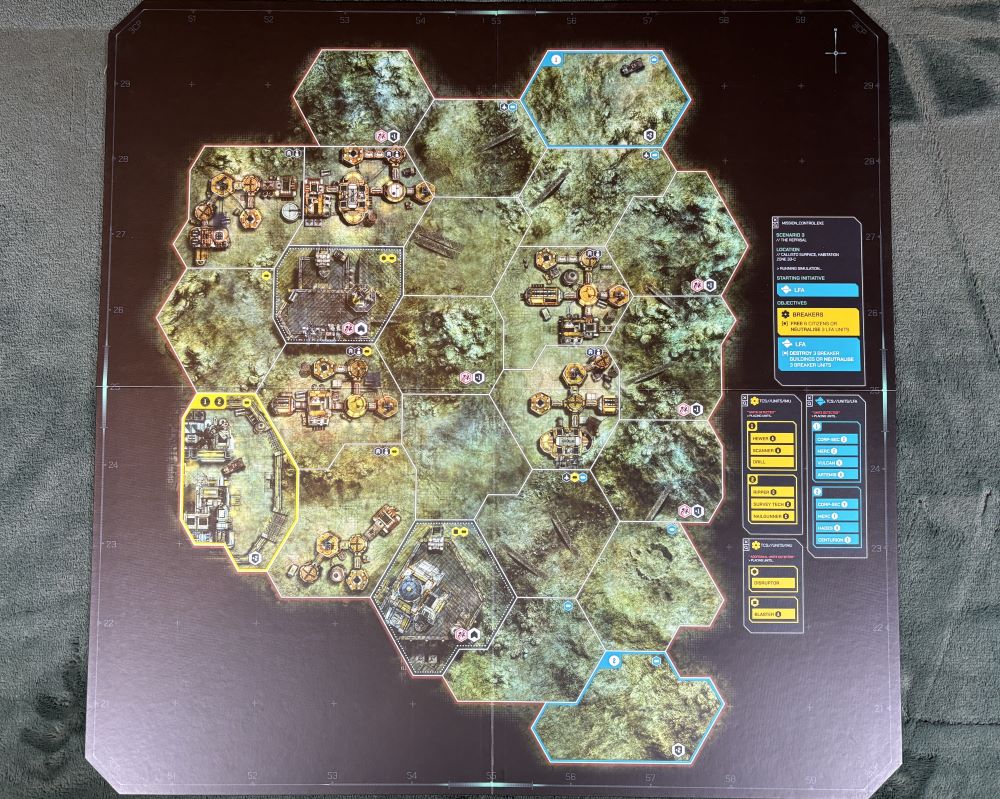
All of the previous games in the Undaunted series used tiles to create battlefield maps on which to move units. However, Undaunted 2200: Callisto replaces these tiles with four double-sided mapboards. This allows for more realistic looking maps that are not limited to the shapes of tiles. Each of the eight maps are created specifically for one of the eight scenarios so they can include much of the information needed for setup. As a result, setting up a game is even quicker than before.
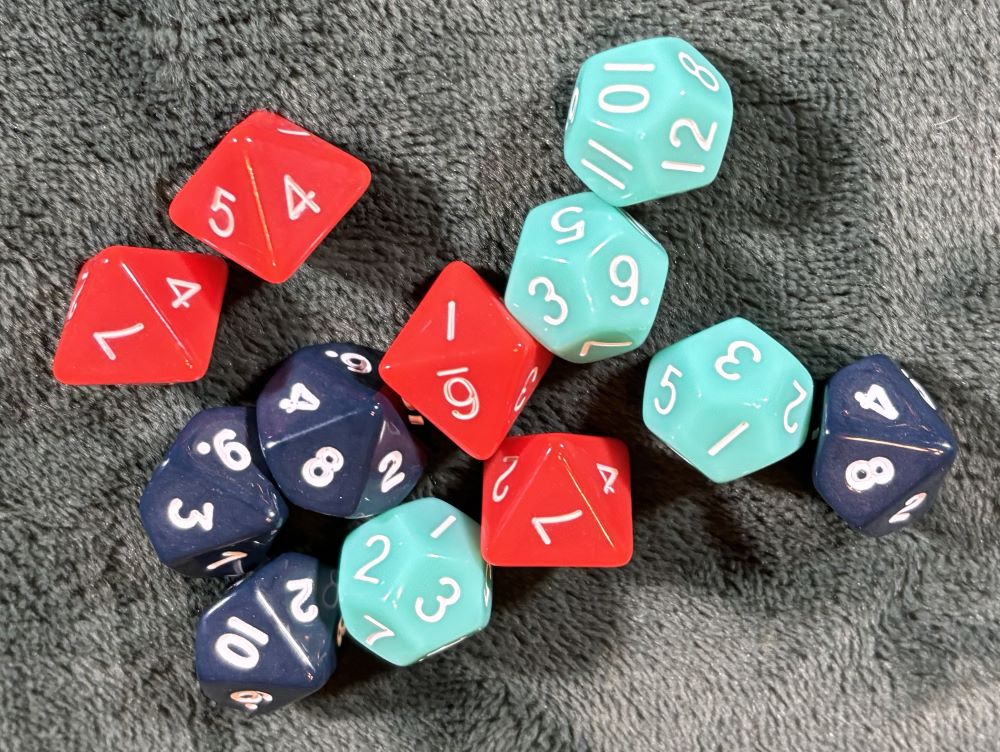
The game comes with 12 dice for resolving combat. There are red d8 dice for use when attacking against an enemy at a higher elevation, blue d10 dice for attacking at the same elevation, and gray d12 dice for attacking enemies at a lower elevation.
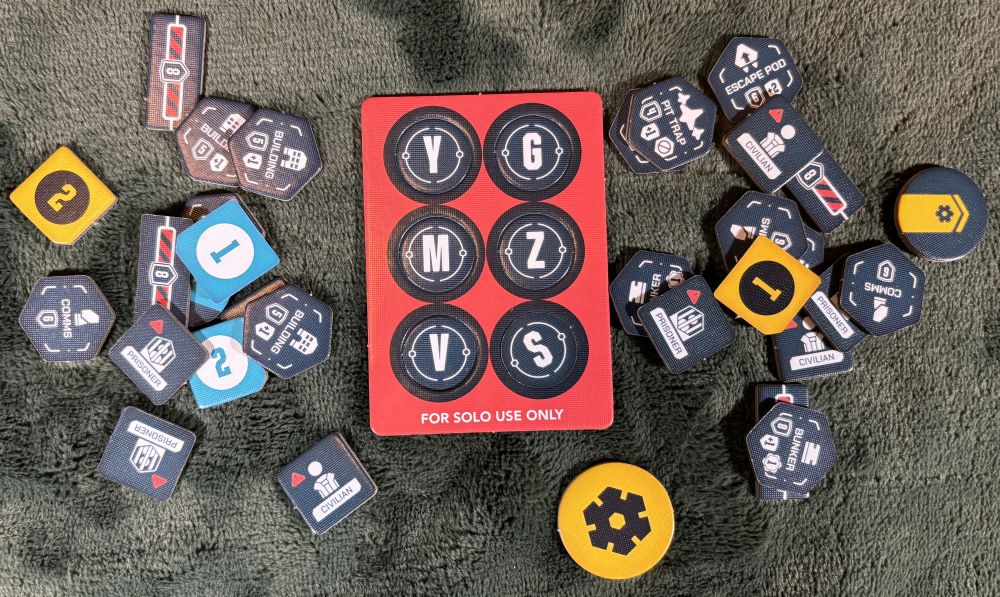
There are a variety of different markers included in the game. Personnel counters represent units on the battlefield. Control markers show which areas have been scouted and which are controlled by one side. Other markers are used to represent structures on the maps as well as organizational functions.
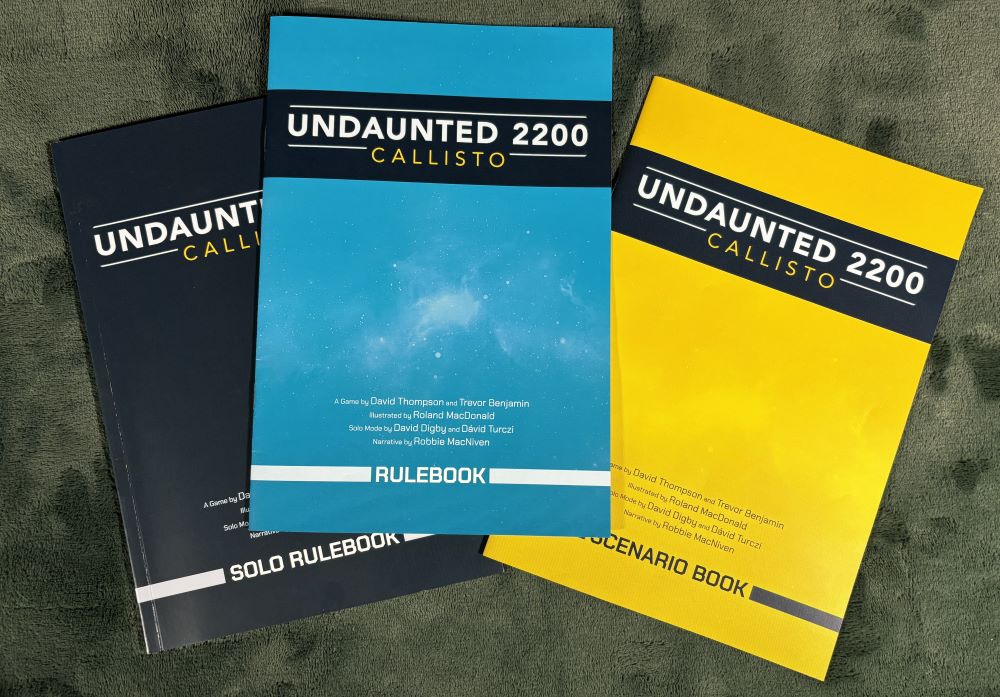
Undaunted 2200: Callisto comes with three different books. The Rulebook describes the rules of the game while the Scenario book provides information on setting up and playing each of the eight scenarios. The Solo book contains rules for playing solo games as well as detailed instructions for how the non-player bots control the units, with details so you can play each of the scenarios as either side.
How to Play Undaunted 2200: Callisto
The Goal
The goal of the game is to complete your side’s victory conditions before the other player completes their victory conditions.
Setup
Start off by selecting a scenario from the scenario book. Next, locate the corresponding mapboard for the scenario and place it in the middle of the player area. Players then choose which side they will play and take all the cards, personnel counters, and control makers listed in the scenario book for their side. The markers and tokens are now placed on the map as shown in the book. Give the initiative token to the player as indicated by the scenario. Now players go through their side’s cards and assemble their starting deck as listed in the scenario and shuffle these cards together face down. Next, assemble the cards listed for your supply. Sort them by type and place them face up near the player to form their supply piles. After returning any leftover cards to the box, you are ready to play.
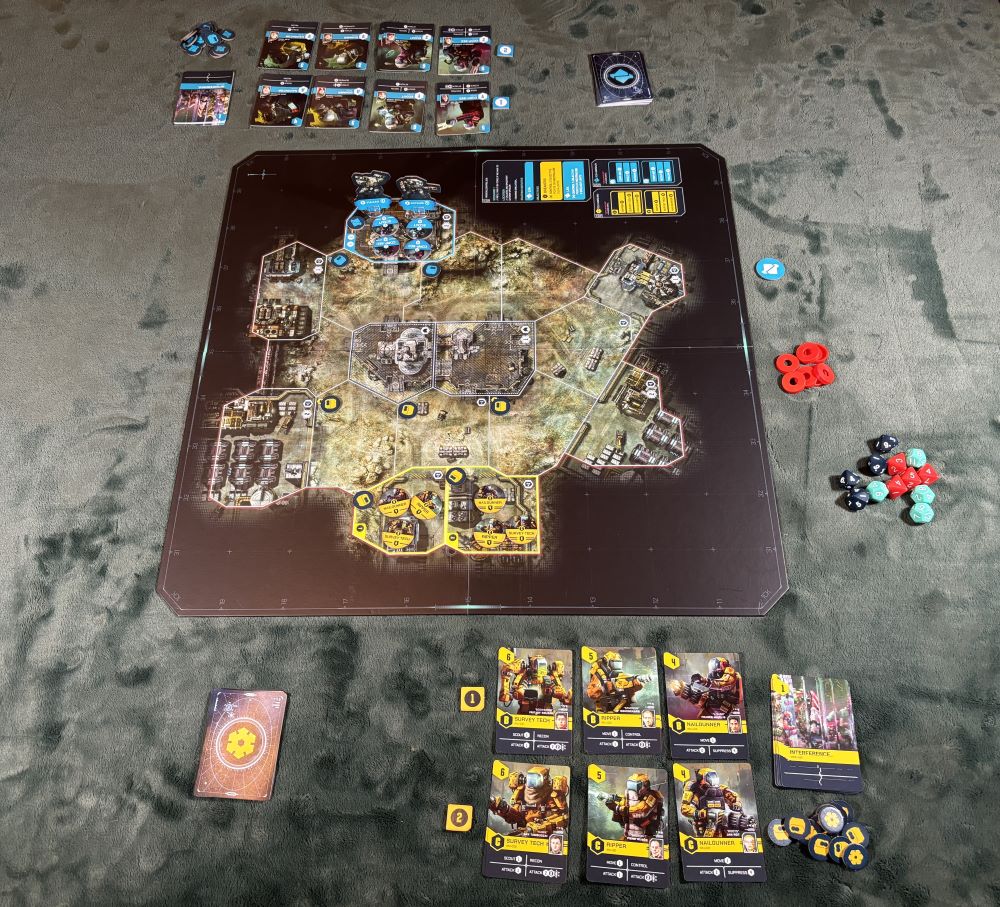
Gameplay
Undaunted 2200: Callisto is played in a series of rounds, each made up of three phases. During the first phase, each player draws four cards from their deck to form a hand. If the deck runs out of cards, shuffle the discard pile to replenish the deck. Next, players determine initiative for the round. To do this, each player secretly selects one card from their hand and place it face down in front of them. At the same time, they reveal their cards. The player who played the card with the highest initiative receives the initiative marker and will perform their actions first for the round. In case of a tie, the player who currently has the initiative keeps it. Both players then discard the card they used for initiative.
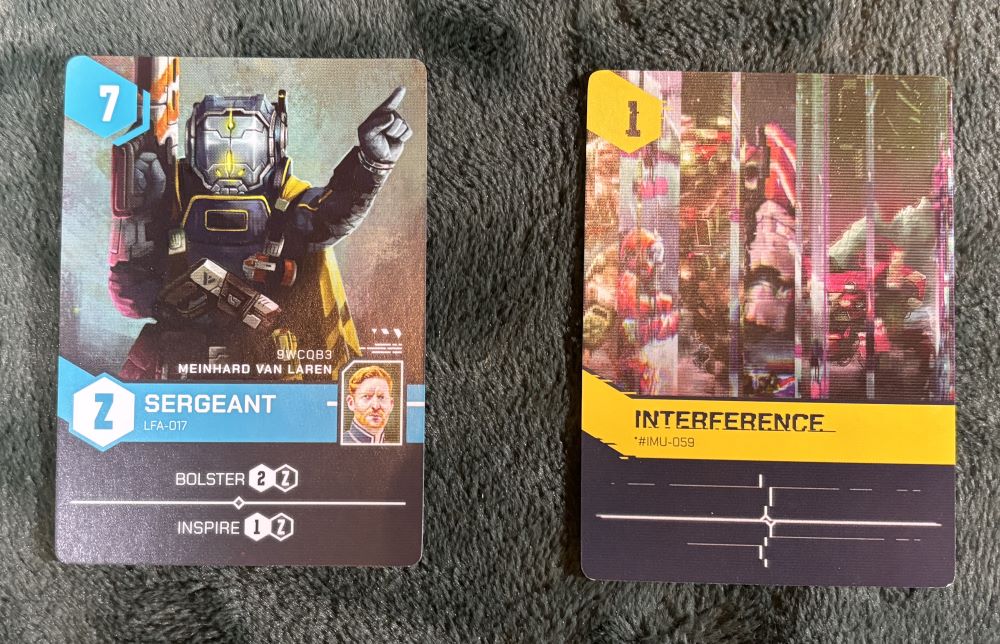
Starting with the player who has initiative, the players then play the cards from their hand until they have none left or they do not wish to play any more. As they play cards, the cards remain in the play area in front of them. Once their turn is complete, all cards left in their hand and those in the play area are placed in the discard pile. Then the other player goes and plays their cards. When a card is played, the player chooses one of the actions listed on the card and plays it in full. Or the player may “hunker down” and return the card to the supply.
The cards represent different types of units and leaders. Units are represented on the map by personnel counters. The typical infantry unit can move, attack, or control. A move action allows the unit to move a number of tiles listed on its card. Attack lets it attack an enemy unit with the number of dice indicated. The control action lets the unit take control of a location. Units can only move onto a location that has already been scouted. Therefore, you need to send out your scout units to scout out tiles so other units may follow behind them. For each tile they scout, you add an interference card to your discard pile. Intgerference cards have no actions and essentially reduce the number of actions you can take during a turn. Luckily, Scout and some other units can perform a recon action which allows you to take an interference card from your hand and remove it from the game. You can then draw a card from your deck into your hand to replace it.
Leader cards represent individuals that support the units but do not have counters on the map. They have some great actions that can really help you. Bolster allows you to take a number of cards from your supply piles and add them to your discard pile. This essentially adds opportunities to use those units in future rounds. Command lets you draw a certain amount of cards from your deck and add them to your hand so you can then play them this round—essentially giving you more actions. The inspire action lets you choose cards from your play area, those you already played this round, and add them back into your hand. This lets you play the same cards a second time during the same round. As you can see, leaders are really force multipliers for their side.
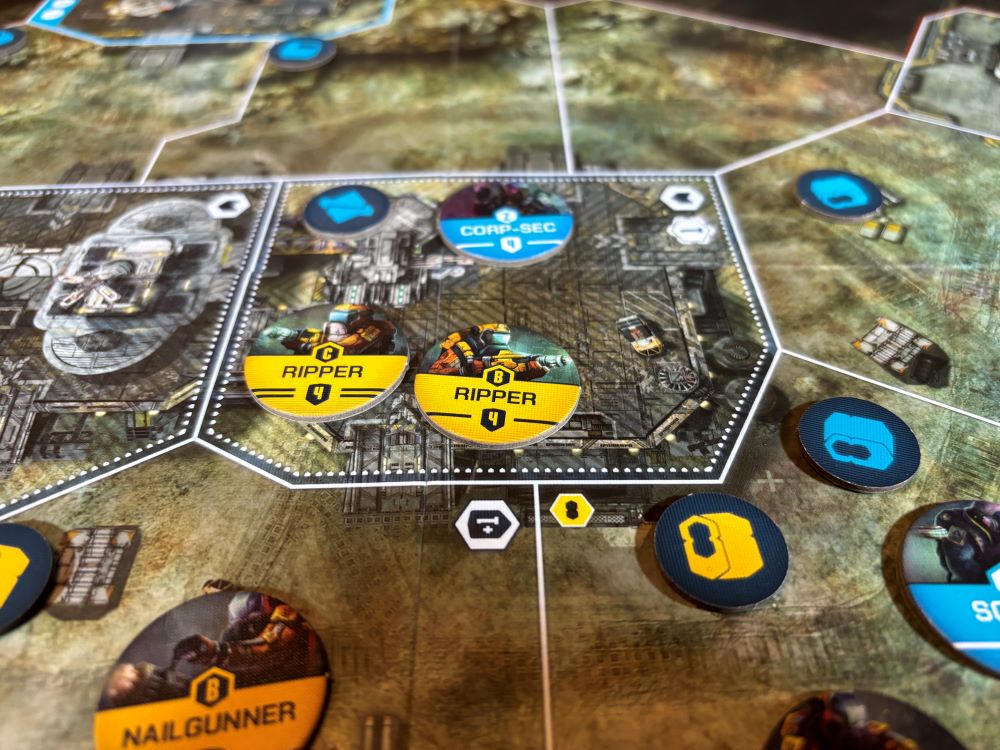
Combat is fairly simple. When you choose to attack with a unit, the number next to the attack order represents the number of dice you roll for the attack. After choosing a target, calculate the total defense value for the target by adding the base defense listed on the combat counter, the cover bonus for the tile in which the unit is located, and the distance between the attacker and target. The attacker then selects the correct dice depending on the elevation difference between the two units and rolls If any of the dice equal to or exceed the total defense, then casualties are inflicted on the target. To do this, the defender must remove a card for the targeted unit. First, remove one from the player’s hand. If there is not a card for that unit in their hand, then remove one from the discard pile. If there are no cards for the unit there, then remove a card from the deck and then reshuffle the deck. If there are no cards for that unit in the deck, then remove the combat counter from the board and the attack holds on to it as a victory condition in some scenarios. In this system, the cards represent the soldiers in the unit. You never remove more than one card for an attack, no matter how many dice succeeded.
Some units can suppress instead of attack. This allows them to roll more dice. However, if their attack succeeds, the targeted unit does not take casualties. Instead, flip that unit’s personnel counter over to its suppressed side. Suppressed units can take no actions until a card for their unit is played for the sole purpose of flipping the counter to its ready side. No other actions may be taken with that same card. However, you could play a second card for that unit and choose any of the actions on it since that unit is now ready to receive orders.
Game End
The game ends when one side has met its victory conditions. This could be controlling objectives, neutralizing enemies, escorting civilians, destroying specific targets, or other scenario specific conditions.
Undaunted 2200: Callisto is GeekDad Approved!
Why You Should Play Undaunted 2200: Callisto
As mentioned earlier, I am a fan of the Undaunted series. So far, all of the titles in the series have been set during WWII. Therefore, when I first learned that the latest title would have a science fiction theme rather than historical, I was a bit leery whether I would like it or not. I did not know if I would like the mapboards that were scenario focused, especially after playing Undaunted: Stalingrad with its numerous tiles that created small sections of a larger overall map for each scenario. However, once I opened the box and saw the mapboards which were right on top, I was very impressed. As I unpacked the contents further, I liked what I saw. The artwork is once again done by Roland MacDonald who also did it for the rest of the series as well as for Western Legends, another game I really enjoy playing. However, the art on the cards is much better than the previous games. Rather than white backgrounds with colored sketches of the soldiers and leaders, the cards in Undaunted 2200: Callisto are on a black background with full color artwork of the personnel as well as their surroundings. The standees representing the mechs and vehicles also have great full color artwork on them and stand vertically in contrast to the personnel markers that lie horizontally on the map. While on the topic of looks, the maps also look incredible and contain a lot of details representative of a Jovian lunar colony. If that were not enough, the box also contains a plastic organizer with spaces for each standees as well as compartments for the cards, markers, and dice as well.
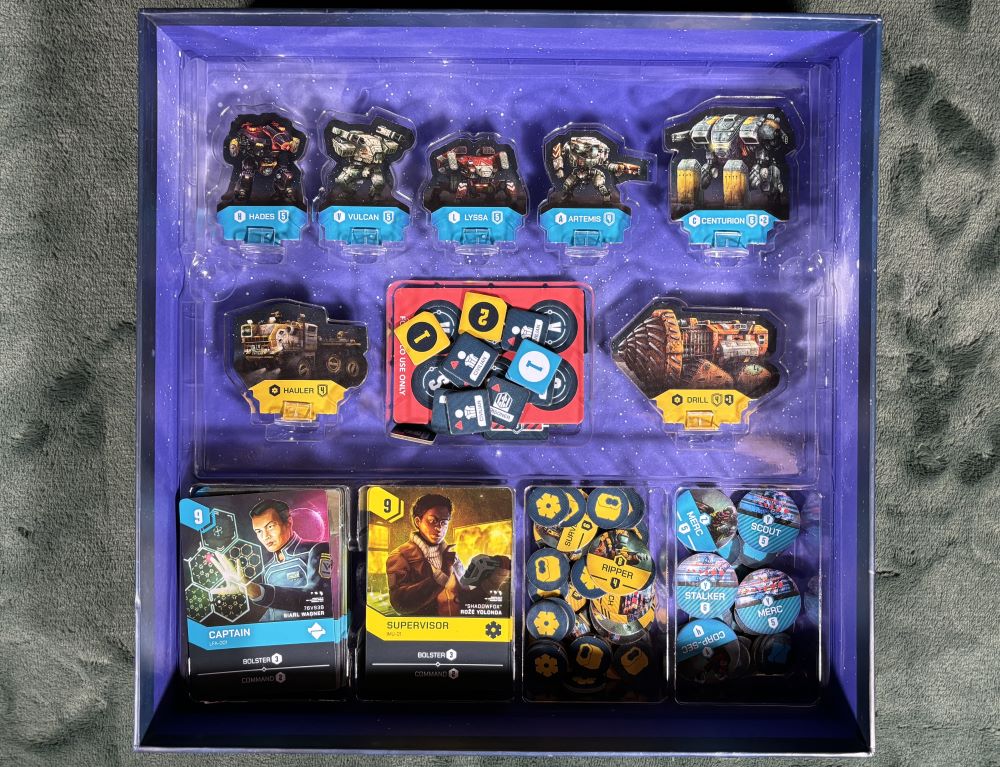
Before I go further, I am sure veterans of the series want to know what is different in Undaunted 2200: Callisto. So let’s get that out of the way. First, control uses the same changes made for Undaunted: Stalingrad. You can take control of a location even if an enemy is there as long as the enemy does not already control it. However, once it is controlled, you need to clear the location of all enemy units before you can take control. Another major change is the addition of elevation. Though there is only two levels of elevation, having the high ground gives you an advantage of rolling d12 dice when attacking down while if attacking up, you only roll d8 dice, making some attacks impossible. This is further solidified by the new rule that there are no automatic successes. In earlier games, if you rolled the highest number on a die, it was an automatic success no matter if the total defense value was higher than the numbers on the die. I like this new addition and I am sure my opponent in Undaunted: Stalingrad agrees since my Russian troops would occasionally make impossible attacks against his German forces. We actually discussed changing that rule ourselves since as a math teacher, he did not like the lack of logic to that rule and all of his tactical decisions were based on mathematical probability.
Another great feature is that the two factions are asymmetrical. The Breakers consist of four squads. A and D squads have Scanners for scouting, Hewers for taking control of locations and fighting, and Blasters which can perform area attacks at a limited range. B and C squads have Survey Techs for the scout role. However, they can only move one space instead of 2 and they have a more powerful attack when in the same location as the enemy. The Rippers are similar to the Hewers as the main fighting units. Then the Nailguners have rapid fire weapons that can be used to suppress as well as attack. The vehicles, the Hauler and the Drill, have the scout ability and can only move one space. Both can attack only enemies in their same location and the Hauler can also suppress. The Breakers also have Disruptors that are not part of squads that have the ability to suppress all of the units, both infantry as well as mech, within the same location. If you have played Undaunted: Stalingrad or Undaunted: Normandy, the Breakers will feel familiar.
The LFA consists of only two squads of infantry. The Scouts are similar to the Survey Techs while the Corp-Sec units are like the Rippers and Hewers. However, Mercs can control like the Corp-Sec and also have a more powerful attack when in the same location as the target. Stalkers are like Scouts, but have a higher attack value. The LFA’s mechs are where the real difference comes into play. In each scenario, the LFA field between 2 and 5 Mechs. Unlike the Breaker vehicles which just have crew cards with all of the actions, each Mech has three crew positions. At the start of the game, the LFA player’s deck contains just a commander who can move, attack, bolster (add cards from supply to the discard pile), and some can suppress. Navigators allow a Mech to use the scout and recon actions while Gunners offer the same attack options. In some ways, Mechs act as their own squads. However, there is only one Commander, two Navigator, and two Gunner cards per mech. Finally, the LFA also have one Drone card. Like a leader card, the drone does not have a marker on the map. It can perform the recon action as well as inspire any of the Mechs. The LFA’s mechs are similar to the way vehicles were used in Undaunted: North Africa. In some of the scenarios, the opposing factions have different objectives. Due to this asymmetry in the game, playing the same scenario at the Breakers feels different than playing as the LFA.
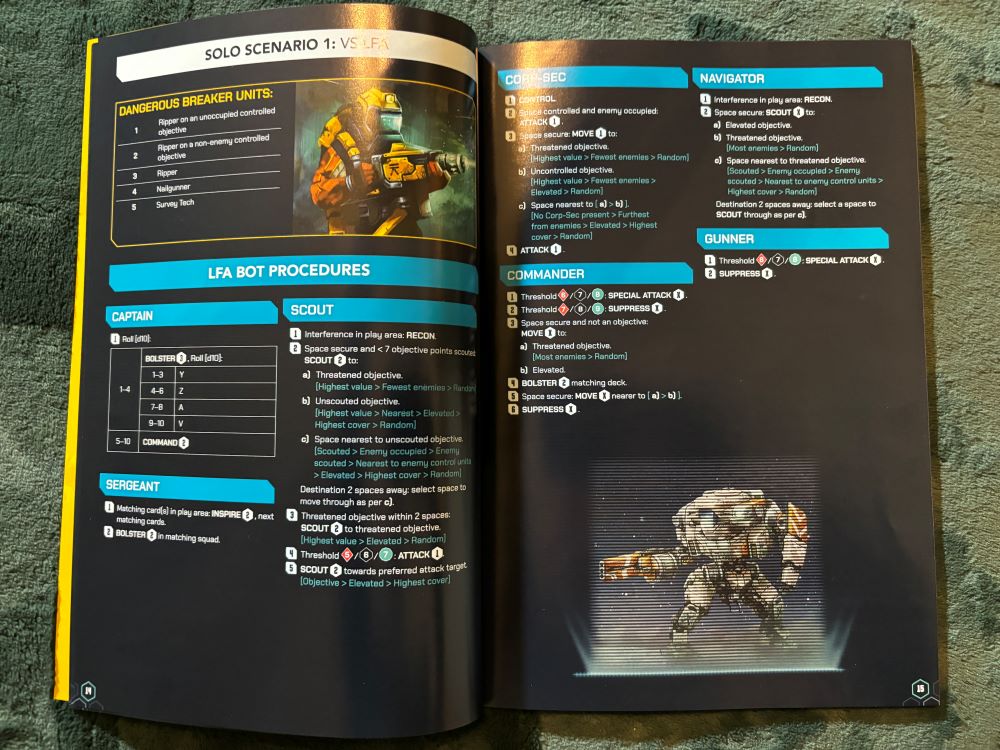
Since the pandemic when people could not get together to play games, solo rules have become an important feature for some players. When Undaunted: Reinforcements added solo rules for both Normandy and North Africa, both game hit the table more often in my home and I really enjoyed playing them solo. While those rules used individual cards for each unit type, Undaunted 2200: Callisto comes with an entire booklet that not only contains the solo rules, but has a two-page spread for each scenario for each faction. It shows not only the setup for each faction, but also lists the options for actions for each unit including conditionals and priorities as well as tiebreakers. The solo rules work very well. It is recommended you play against another person until you are familiar with the mechanics and rules of the game. However, once you know the basics, the solo games are a great way to learn the scenarios and test out tactics you can use next time you have a live opponent. In addition to the solo rules, Undaunted 2200: Callisto also has rules for four players where each faction’s units are divided up between two players who work as a team. Overall command depends on who has the commander card in their deck. However, when they use that card, instead of placing it in their discard pile, they place it in the discard pile of their teammate. All of the scenarios already have the units divided into two teams, so it is very easy to switch from 2 to 4 players. This allows the game to hit the table during game nights and offers a great opportunity to introduce new players to the series.
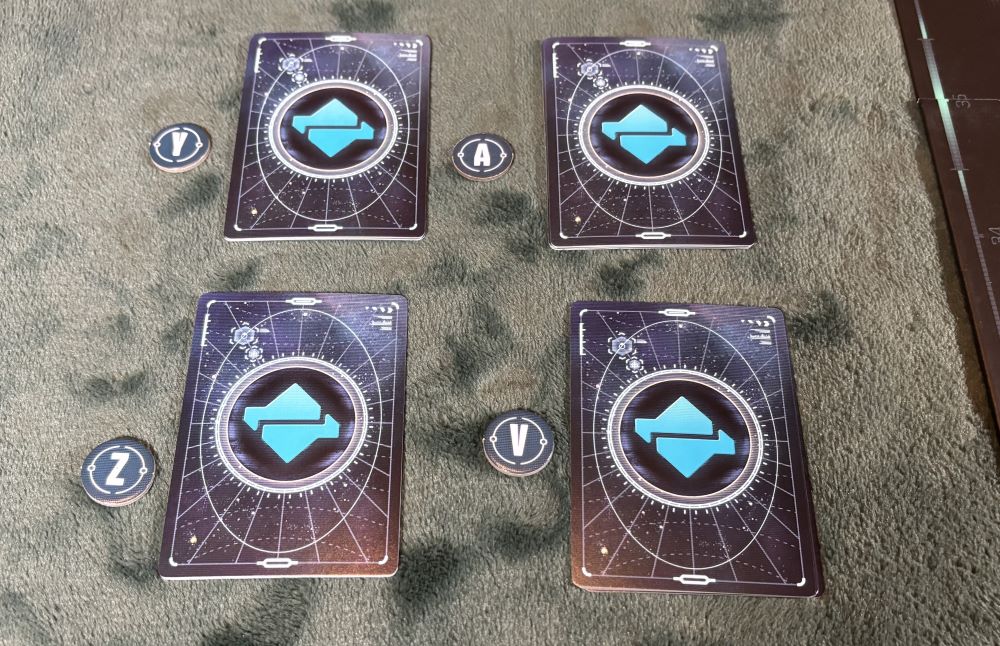
Another reason I really like Undaunted 2200: Callisto is that it is so quick to bring to the table. From the time you open the box, you can be playing in under five minutes if you have played before. The scenario book makes setup quick and I really appreciate the mapboards. There is no need to hunt for a dozen or more tiles and put them in the correct positions. The mapboards even list the teams as well as the game objectives on them. While setting up a solo game might take a few more minutes since one person is preparing both factions, it is still quick. As a result, you can usually get in a game from opening to cleanup in about an hour.
In the end, Undaunted 2200: Callisto is a lot of fun to play. While I have really enjoyed playing the other games in the series, especially Undaunted: Stalingrad, I think Undaunted 2200: Callisto may be my favorite right now. When you combine the easy of setup, the asymmetry of the factions, the quality of the components and the beautiful artwork along with a really fun system of mechanics that include deck building, dice rolling, and hand management, along with a great solo play system, it is easy to see why this game deserves to be awarded the GeekDad Approved designation. Whether you are a veteran of the Undaunted series or have never played them before but are looking for a unique type of wargame, I highly recommend Undaunted 2200: Callisto. In the several times I have played either solo or with another player, I have always had an enjoyable experience and want to continue playing. I can’t wait to see what David Thompson and Trevor Benjamin have planned next for the series.
For more information, visit the Undaunted 2200: Callisto page!
Click here to see all our tabletop game reviews.
![]() To subscribe to GeekDad’s tabletop gaming coverage, please copy this link and add it to your RSS reader.
To subscribe to GeekDad’s tabletop gaming coverage, please copy this link and add it to your RSS reader.

